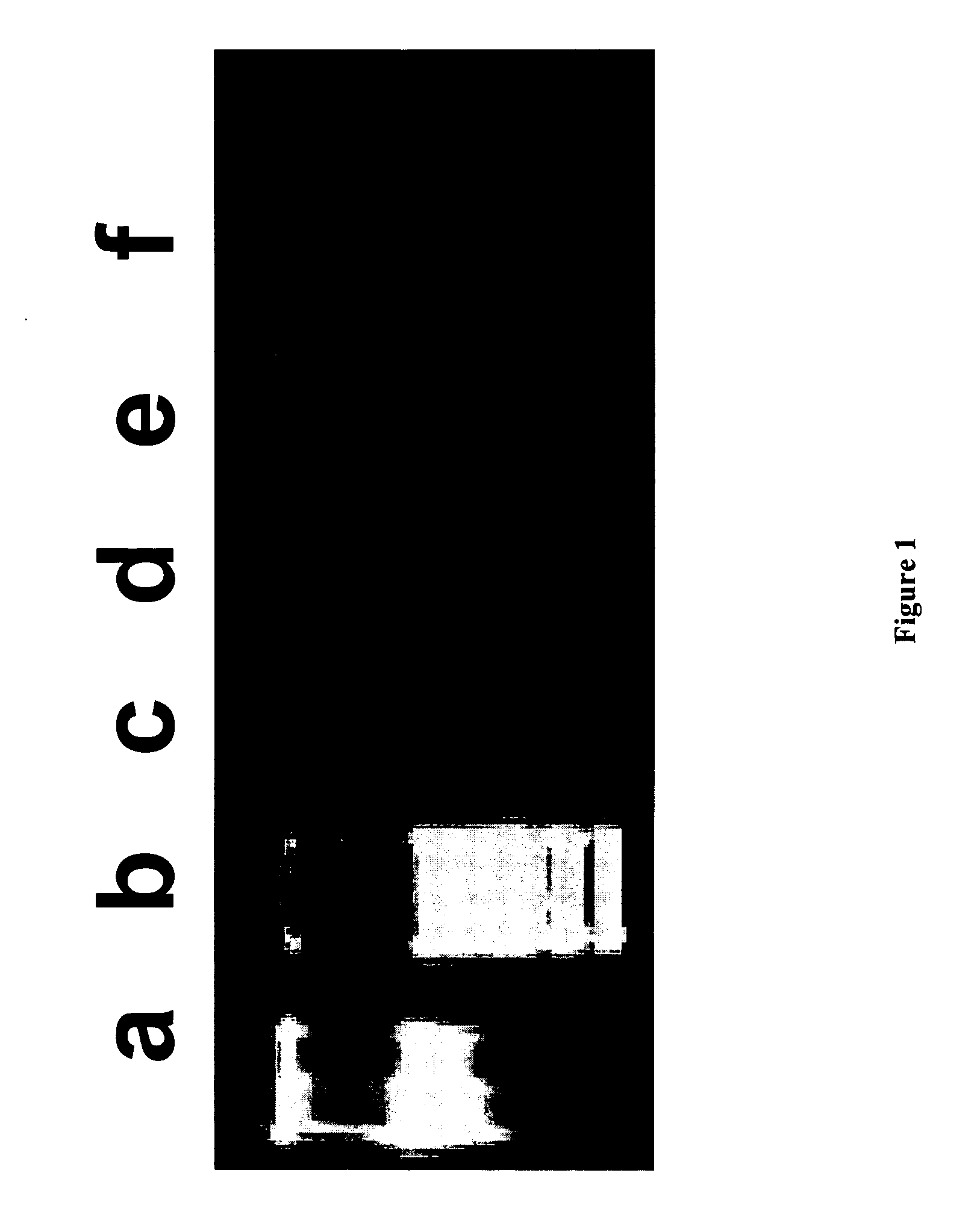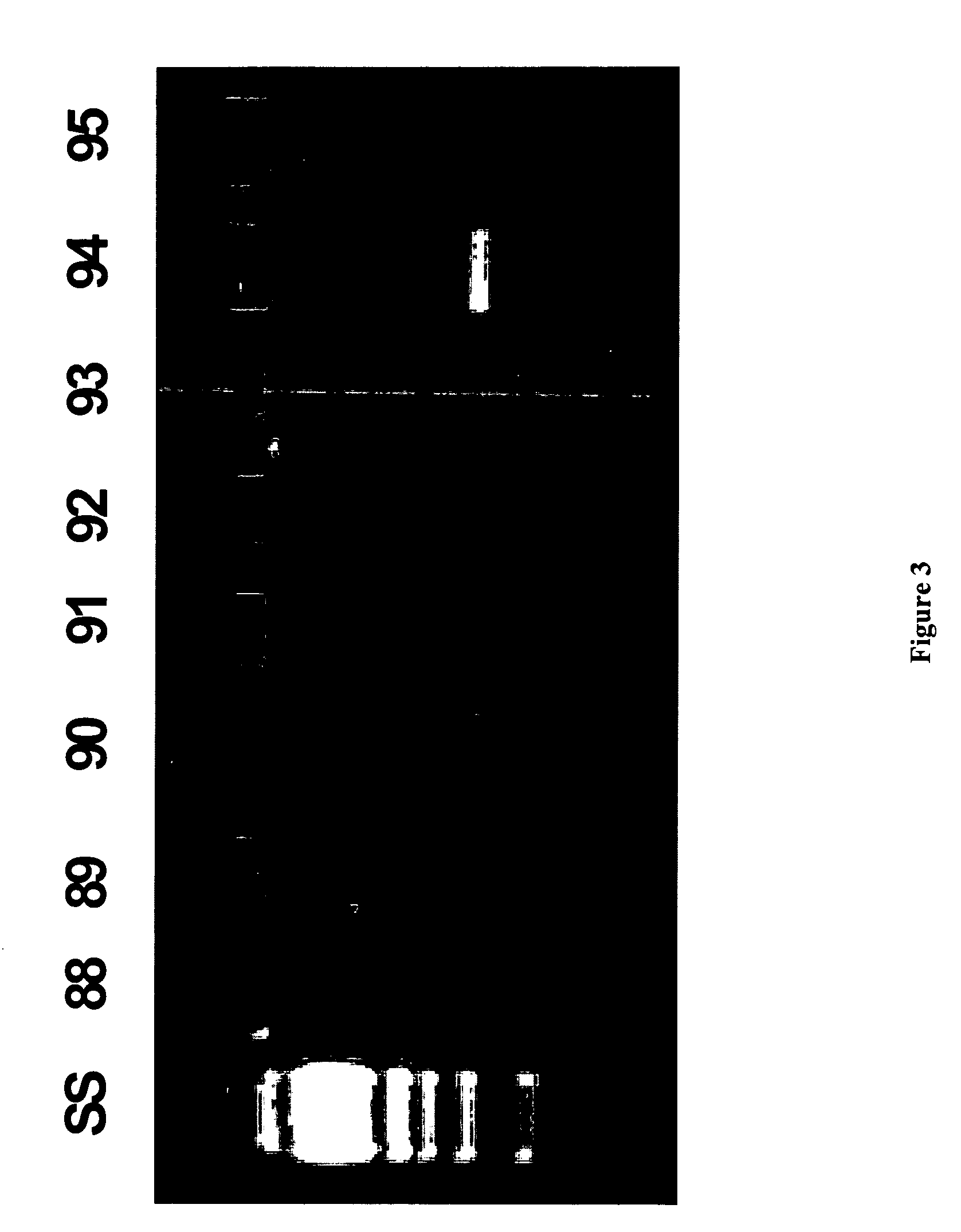Methods for repairing degraded DNA
a dna repair and dna technology, applied in the field of amplification of dna, can solve the problems of chemical production breakage, chemical amplification failure, and conversion to a normal base mismatch
- Summary
- Abstract
- Description
- Claims
- Application Information
AI Technical Summary
Problems solved by technology
Method used
Image
Examples
example 1
Repair of Irradiated Double-Stranded DNA Prior Use in Multiple Displacement Amplification
[0045] Irradiation of DNA is used herein as a means to artificially damage DNA in order to investigate the capability of DNA repair enzyme mixtures to repair the damage. As shown in FIG. 1, human mitochondrial DNA exposed to 4 mega-rad of radiation (lanes c-f) is not amplifiable by whole genome amplification (WGA) effected by multiple displacement amplification (MDA), presumably due to the large frequency of nicks and degraded nucleotides. Likewise, the same radiation treatment results in poor PCR amplification of the HV2 region of human mitochondrial DNA relative to non-irradiated control DNA samples (FIG. 2). A significant difference in the amount of irradiated DNA needed in a PCR reaction in order to obtain a detectable PCR product was observed. This observation was fortuitous because it enabled a quick test of DNA repair formulations and conditions to quickly assess their effects on improvi...
example 2
Whole Genome Amplification of Genomic DNA by Multiple Displacement Amplification Using Φ29 Polymerase
[0051] The following method has been found to be effective for whole genome amplification of DNA:
TABLE 2Reaction Components for Whole Genome AmplificationComponentsFinal ConcentrationStarting DNA1 pg-100 ngWaterNA10× NEB Φ29 Rxn Buffer, Supplied1×with polymerase.Modified-Random Primers (1 mM) equal50uMpart mix of hexamers, heptamers and octamersCustom ordered from IDT-DNA-thiophosphatelinkages for the last two 3 prime nucleotidesDNTPs (100 mM mix) Stratagene Corp.2mMΦ29 polymerase (10,000 units / ml.) -16UnitsNEB cat # M0269LPyrophos-phosphatase (40 u / ml stock) -0.008UnitsAmersham cat # E70953ZBSA-Acetylated- Ambion Cat # 2612 (20 mg / ml)200ug / ml0.1 M DTT - Invitrogen cat # Y001475mM
wherein NEB buffer is 50 mM TRIS-HCl, 10 mM MgCl2, 10 mM (NH4)2SO4, 4 mM DTT, pH 7.5 at 25° C.
[0052] A sample of DNA is diluted with nuclease-free water to a volume of 62 μl in a 200 μl PCR tube, to whi...
example 3
Inactivation of Contaminating DNA in Φ29 Polymerase
[0059]FIG. 4 demonstrates that commercially obtained Φ29 polymerase used for whole genome amplification reactions is contaminated with DNA which can be destroyed by irradiation with ultraviolet light. The left half of the gel shows the effect of irradiating the enzyme preparation for 10 sec, 30 sec, 2 min. and 4 min. prior to amplification of a 1 ng sample of human DNA. The gel indicates that the extent of amplification is essentially equivalent for each of the four reactions. In contrast, the right half of the gel indicates that contaminating DNA is amplified in the absence of expressly added human DNA template, but that this contaminating DNA fails to amplify to the same extent when the Φ29 polymerase preparation is exposed to ultraviolet light for 2 to 4 minutes. This experiment indicates that an added step prior to carrying out a WGA reaction wherein the Φ29 polymerase preparation is irradiated with ultraviolet light to destroy...
PUM
 Login to View More
Login to View More Abstract
Description
Claims
Application Information
 Login to View More
Login to View More - R&D
- Intellectual Property
- Life Sciences
- Materials
- Tech Scout
- Unparalleled Data Quality
- Higher Quality Content
- 60% Fewer Hallucinations
Browse by: Latest US Patents, China's latest patents, Technical Efficacy Thesaurus, Application Domain, Technology Topic, Popular Technical Reports.
© 2025 PatSnap. All rights reserved.Legal|Privacy policy|Modern Slavery Act Transparency Statement|Sitemap|About US| Contact US: help@patsnap.com



